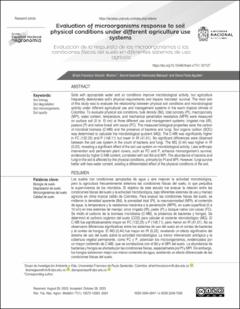Evaluation of microorganisms response to soil physical conditions under different agriculture use systems
...
Visconti Moreno, Efrain Francisco | 2024-01-01
Soils with appropriate water and air conditions improve microbiological activity, but agriculture frequently deteriorates soil’s physical requirements and impairs microbes’ survival. The main aim of this study was to evaluate the relationship between physical soil conditions and microbiological activity under different agricultural use and management systems in the warm tropical climate of Colombia. To evaluate physical soil conditions, bulk density (Bd), total porosity (Pt), macroporosity (MPt), water content, temperature, and mechanical penetration resistance (MPR) were measured on surface soil (0 to 10 cm) at three different use and management systems: irrigated rice (IR), pasture (P) and native forest with cacao (FC). The measured biological properties were the carbon of microbial biomass (C-MB) and the presence of bacteria and fungi. Soil organic carbon (SOC) was determined to calculate the microbiological quotient (MQ). The C-MB was significantly higher in FC (132.25) and P (148.11) but lower in IR (41.61). No significant differences were observed between the soil use system in the count of bacteria and fungi. The MQ (0.44) was higher in IR (0.22), revealing a significant effect of the soil use system on microbiological activity. Less anthropic intervention and permanent plant covers, such as FC and P, enhance microorganism’s survival, evidenced by higher C-MB content, correlated with soil Bd and MPt. The abundance of bacteria and fungi in the soil is affected by the physical conditions, primarily by Pt and MPt. However, fungi survive better with less water content, existing a differentiated effect of the physical conditions of the soil.
LEER










